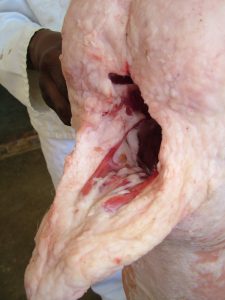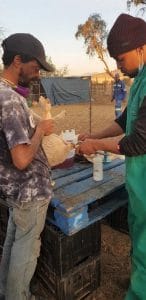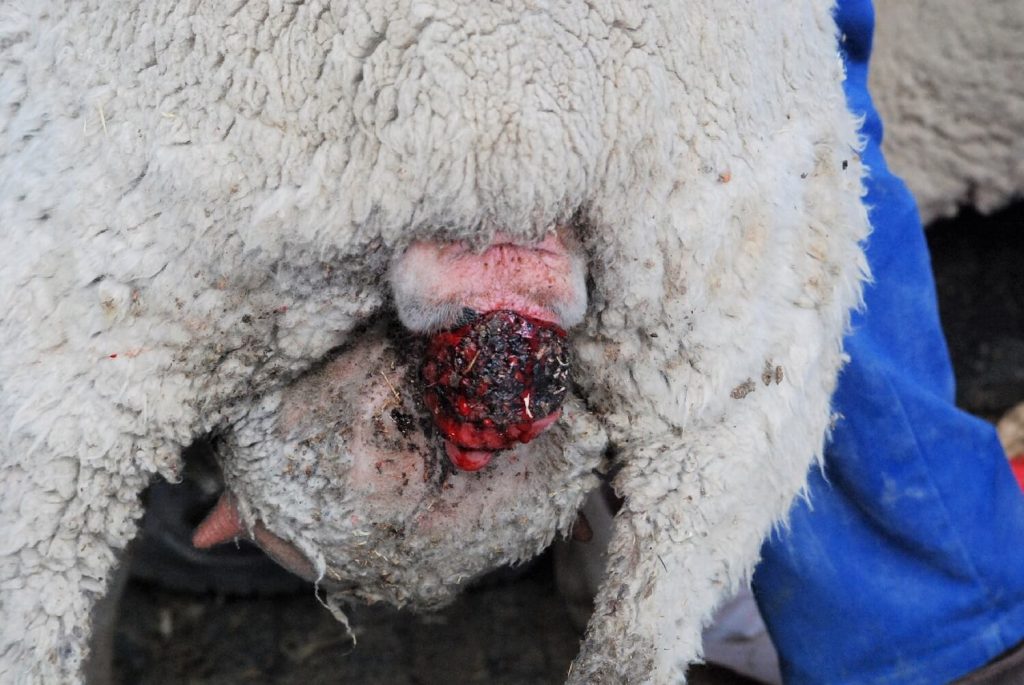Tail docking is usually performed in sheep and involves both surgical and non-surgical methods to shorten or remove the tail. While some people may feel discomfort or squirm at the thought, many producers routinely dock a lamb’s tail when it is only a few days old.
Tail docking in sheep is based on the following principles:
- In fat-tailed sheep breeds, tails are docked to prevent fat from accumulating in the tail.
- In wool breeds, faeces and urine that soil the tail is blamed for blowfly strike.
- There is a perception that ewes with long tails may not be mated successfully.

at the same length and natural
narrowing of the tail indicates where the
support muscles of the anus and vagina
ends. Tail docking should not damage
these muscles.
According to Dr Johan van Rooyen, veterinary specialist practitioner for small stock at Steynsburg Animal Hospital, these reasons for tail docking lack some credibility. “There is very little evidence to support the statement that cutting tails improves the health of non-wool breeds. In addition, the benefits in terms of conception rate and prevention of blowfly strike in wool breeds are not always clear. In my opinion the main reason for tail docking adds up to aesthetic reasons and peer pressure from those who believe that sheep with tails will resemble a slapdash or careless way of farming.”
Tail docking is not mandatory, and many producers are no longer docking their lambs’ tails. “It is worth noting that tail docking is perceived as a potential hazard by animal rights groups who are targeting all procedures on animals that could be painful or dangerous,” says Dr Van Rooyen. “However, if it is performed, it should be done as professionally as possible.”
If a producer chooses to follow this route, the procedure must be done as soon as possible after a lamb has been born. According to Dr Van Rooyen, many stud producers ‘tag and tail’ lambs when they are seven days old. He notes that it is best to dock lambs’ tails, preferably using the Burdizzo method, before three weeks of age. “One can expect some problems in lambs between three and six weeks old, while the procedure is very risky in older sheep.”
Setting up handling facilities
Where handling facilities are concerned, dusty kraals must be avoided. Portable pens are ideal for setting up temporary camps, minimising the need for lambs to walk long distances after the procedure has been carried out. A gazebo can be very handy to provide shade for workers and cool drinking water should also be available. Most important of all is that the procedure must be completed as methodically as possible without rushing.
Methods of tail docking

Tail docking can be done using one of several methods:
Burdizzo method
Hold the lamb by all four legs and spray povidone iodine around the area of the tail to be docked. Find the correct joint and apply the Burdizzo to the area, but do not close it yet. Pull the loose skin of the tail towards the rump of the animal and close the Burdizzo, which will then crush the tail and cut off the blood supply. Using a scalpel or narrow knife, cut the tail completely off inside the Burdizzo. Clean and disinfect the Burdizzo and knife after each tail docked.
Rubber ring method
Hold the lamb by all four legs and spray the tail with povidone iodine. Apply the rubber ring, or elastrator, and pull the skin towards the rump before releasing the ring. This procedure causes lambs to experience acute pain for a few hours and they will often lie down, roll around and exhibit other behavioural changes. Some producers cut off the ring as well as the necrotic tail after three days, believing it can prevent problems. Dr Van Rooyen does not encourage this, as it involves unnecessary handling and an increased risk of injury.
Gas burner/cutter method
Hold the lamb by all four legs and use a very warm gas burner/cutter to cut off the tail. With this method the risk of infection is very low, although the wound is painful and takes long to heal. There is a risk of burning the vulva if the lamb is not held properly, while injury to the handler and operator is also possible. Working with gas on windy days can prevent reaching a high enough temperature to ensure fast and accurate cutting.
Emasculator method
An emasculator both cuts and crushes in one action. Povidone iodine must be applied before cutting. If the lamb is not well restrained, the instrument can slip, which may result in bleeding.
Surgical method
A knife or scalpel is used for docking. This technique is not recommended since it causes bleeding. It is especially dangerous if lambs had to walk over a long distance in hot weather.
Risks involved in docking
Dr Van Rooyen notes that carelessness during tail docking can result in disease, mortality or production losses in animals. The following risks are among the most common:
Prolapsed rectum and vagina
When tails are docked too short, the risk of rectal or vaginal prolapse is increased.

Sunburn
Drastic docking exposes the vulva to sunburn and tick bites (attracted to the sunburnt skin) and according to Dr Van Rooyen, cases of cancer from sunburn can follow. Moreover, it is not uncommon for infection to occur in the wound. This causes infection in the spinal cord that can lead to partial paralysis of the hind limbs – an animal will drag its hind legs, or even completely lose its balance.

Tetanus
This disease often develops when elastic rings are used. The tetanus-causing bacteria enter the tissue where it multiplies in anaerobic conditions and approximately ten days after the application of the rubber ring, a lamb will develop various degrees of spastic paralysis. Tetanus can increase the mortality among lambs, leading to sizeable losses. However, vaccinating the ewe may prevent tetanus if the lamb ingests sufficient colostrum within the first six hours of its life.

Blood loss
If the arteries are not sufficiently crushed, the lamb may start bleeding. It is also essential to put the lamb down carefully on all four its legs to prevent it from bumping or dirtying the wound.
Heat stress
Lambs should not walk long distances before or after tail docking since it increases the possibility of blood loss and prolongs the healing process.
Disease transmission
The infectious blood disease anaplasmosis, which involves anaemia and jaundice, can occur in lambs. “It is easily transmitted from one lamb to another and our practice has observed outbreaks following tail docking with unsterilised instruments,” says Dr Van Rooyen.
Weak and sick lambs
It is not advisable to subject lambs in poor condition, or those with ticks or parasites, to tail docking. It is best to give them ample time to recover or not to dock them at all.
Financial implications
Lambs that have not been docked, or that were docked at a very young age, experience no growth depression, according to Dr Van Rooyen, while the Burdizzo technique has the least effect of all, followed by gas burning. However, mortality is a real possibility under certain circumstances, and the loss of a few hundred grams in weight in each lamb can amount to a substantial loss in the entire flock (e.g. 100g x 1 000 lambs = 100kg = R4 000).
Tail docking does not have to be expensive. The only consumables used when applying the Burdizzo method, for example, are povidone iodine, disinfectant, scalpel blades and wound aerosol; the only expenses when applying the elastrator and gas burner/cutter methods are rubber rings, povidone iodine and gas.
Effect on the environment
The only environmental issue with regard to tail docking is the use of chemicals or medication such as antibiotics, which can be avoided by following hygienic procedures during the process. – Carin Venter, Stockfarm
For more information, contact the Steynsburg Animal Hospital on 087 551 2783 or send an email to veearts.sdh@nokwi.co.za.








